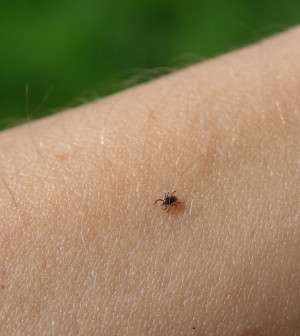- Navigating Your Midlife Crisis: Embracing New Possibilities
- City Raccoons Showing Signs of Domestication
- Mapping the Exposome: Science Broadens Focus to Environmental Disease Triggers
- One Week Less on Social Media Linked to Better Mental Health
- Your Brain Changes in Stages as You Age, Study Finds
- Some Suicide Victims Show No Typical Warning Signs, Study Finds
- ByHeart Formula Faces Lawsuits After Babies Sickened With Botulism
- Switch to Vegan Diet Could Cut Your Greenhouse Gas Emissions in Half
- Regular Bedtime Does Wonders for Blood Pressure
- Dining Alone Could Mean Worse Nutrition for Seniors
Ebola Linked to Rise in Malaria Deaths in Guinea


The Ebola epidemic in West Africa appears to have led to an increase in malaria deaths last year, a new study finds.
Research in Guinea, one of the countries hardest hit by the Ebola epidemic, indicates an extra 74,000 cases of malaria went untreated in 2014, compared to previous years. As a result, deaths associated with malaria (a mosquito-borne disease) also rose and will likely exceed Ebola deaths in Guinea, researchers reported June 23 in The Lancet Infectious Diseases.
“One problem is that the early symptoms of malaria [fever, headache and body aches] mimic those of Ebola virus disease,” said study author Dr. Mateusz Plucinski, from the U.S. Centers for Disease Control and Prevention.
“Malaria is one of the main causes of fever and health facilities visits in Guinea, but our data suggest that since the start of the Ebola epidemic, people with fevers have avoided clinics for fear of contracting Ebola or being sent to an Ebola treatment center,” Plucinski said in a journal news release.
The researchers surveyed 60 public health facilities in some of the areas hit the hardest by the deadly Ebola virus in Guinea. They also surveyed 60 clinics in areas unaffected by Ebola, interviewed health care workers and examined malaria indicators between 2011 and 2014 to determine the effect the Ebola epidemic had on malaria treatment.
Health clinics that stayed open during the Ebola epidemic saw a 42 percent drop in outpatient visits in some age groups, the researchers found. There was also a 69 percent drop in the number of malaria cases treated at those facilities.
Compared to 2013, the number of people treated with pills for malaria fell by 24 percent and those treated with injectable drugs dropped by 30 percent, the study found. Even in areas with no reported Ebola cases, the number of reported and treated malaria cases declined dramatically.
Also, in the most affected areas, the proportion of community health workers who were working fell from 98 percent before the Ebola epidemic to 74 percent after. Those actively treating malaria fell from two-thirds to about 48 percent, the findings showed. Meanwhile, the number of health workers in areas unaffected by Ebola increased.
“Untreated malaria cases lead to rising malaria death rates and more cases of fever in the community,” said Plucinski. “This puts extra pressure on an already overburdened health system owing to a greater number of suspected Ebola cases requiring triage and isolation at treatment centers.”
Malaria control efforts and delivery of care must be kept on track during an Ebola epidemic, so that progress made in malaria control is not jeopardized and Ebola response is not impeded, he added.
In areas affected by both Ebola and malaria, the World Health Organization recommends malaria treatment for all patients with a fever and malaria drugs for people working where malaria transmission is high.
While some cases of Ebola continue to emerge, health officials believe the worst of the epidemic is over. So far, Ebola has caused 2,473 deaths in Guinea alone, according to the CDC.
More information
The U.S. Centers for Disease Control and Prevention has more about Ebola.
Source: HealthDay
Copyright © 2025 HealthDay. All rights reserved.










